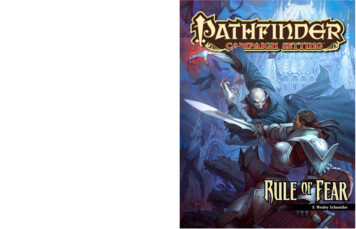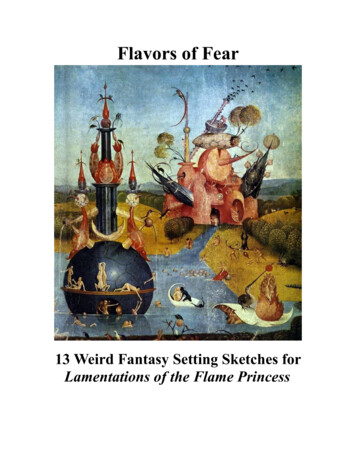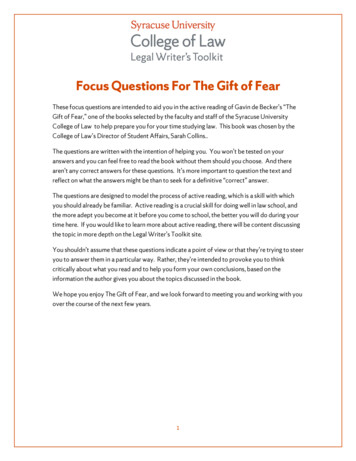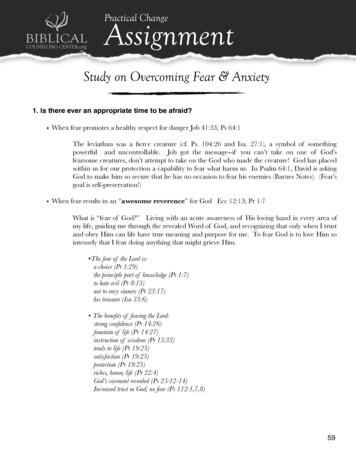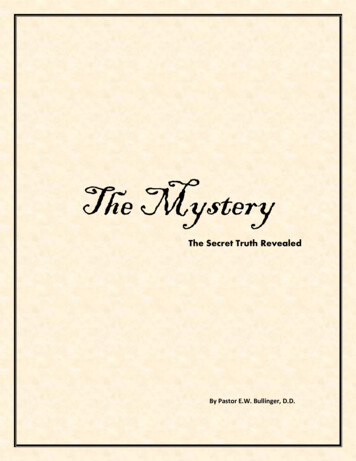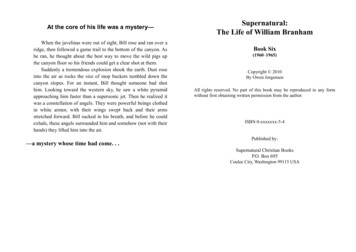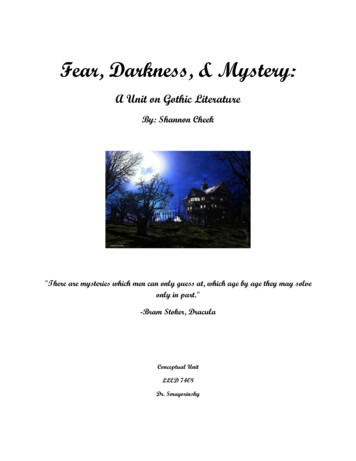
Transcription
Fear, Darkness, & Mystery:A Unit on Gothic LiteratureBy: Shannon Cheek"There are mysteries which men can only guess at, which age by age they may solveonly in part."-Bram Stoker, DraculaConceptual UnitLLED 7408Dr. Smagorinsky
I.MaterialsPoemsoooo“Because I could not stop for Death” by Emily DickinsonPoems by Edgar Allan Poe1. “Annabel Lee”2. “To Helen”3. “The Haunted Palace”4. “The Raven”“My Last Duchess” by Robert BrowningSelect poems from Spoon River Anthology by Edgar Lee Masters:1. “Andy the Night Watch”2. “Mary McNeely”3. “Serepta Mason”4. “Percy Bysshe Shelley”Short StoriesoooStories by Edgar Allan Poe:1. The Fall of the House of Usher2. The Masque of the Red Death3. Ligeia4. The Black Cat5. The Cask of Amontillado6. The Oblong Box7. The Oval Portrait8. The Tell-Tale Heart9. The Purloined LetterThe Legend of Sleepy Hollow by Washington IrvingA Rose for Emily by William FaulkneroDreadful Sorry by Kathryn ReissooooooFilm clip: Rebecca by Daphne du MaurierFilm clip: Wuthering Heights by Emily BronteFilm clip: Jane Eyre by Charlotte BronteFilm clip: The Turn of the Screw by Henry JamesFilm clip: Northanger Abbey by Jane AustenBrief clip of Film: CoralineNovelExcerpts
II.RationaleGothic literature has been a popular and beloved genre for many years. It is significant becauseit contains “the surreal, raised to the level of poetry which is the very essence of ‘gothic’: that whichdisplays the range, depth, audacity, and fantastical extravagance of the human imagination” (Oates 9). Iwill be teaching this unit to regular track freshmen in a rural or suburban high school with approximatelytwenty-five students per class. Human emotion plays a large part in this genre, especially fear, terror,and horror, though these texts are often characterized by sadness, loneliness, confusion, anduncertainty as well. My overarching theme for the entire course is human emotion and its significance inliterature, both classic and contemporary. The unit on Gothic literature represents the darker side ofhuman nature and emotions. I believe it is important to study a full spectrum of emotions; that meansincluding the darker works as well. The emotions associated with Gothic literature are the main focus ofthis unit, though there are several other concepts that I am integrating as well.Gender roles are also noteworthy in Gothic literature, not only within the stories, but alsobecause of the amount of female writers within the genre. In this unit, in order to show female authorsand their perspectives on Gothic literature, I include works, excerpts, and clips from Emily Dickinson,Charlotte and Emily Bronte, Jane Austen, Daphne du Maurier, and a contemporary author, KathrynReiss. In the past, “women took up writing Gothic novels as a way to make a living,” which means thatthere are plenty of female Gothic texts to choose from (Sime 276). For the male perspectives, I includeworks, excerpts, and clips from Edgar Allan Poe, Thomas Gray, Edgar Lee Masters, Robert Browning,William Faulkner, Washington Irving, and Henry James. I have selected a combination of poetry, shortstories, and a novel, along with some excerpts of books and films so that the Gothic themes arerepresented in various forms.
Gothic literature is essential to students’ educations because it is both historically and culturallysignificant in numerous ways. First, the themes within the literature are timeless: just as people havealways loved ghost stories around a campfire and the gusto with which many celebrate Halloweenindicate that people appreciate still the importance of Gothic elements. There is a type of excitementand suspense created within a Gothic tale that is difficult to place within other types of literature.People are able to satisfy a desire for a good scare through a vicarious experience. These types of storiesare excellent at keeping the interests of students in the ninth grade, and most of them adore Gothictales. Not only is the literature interesting to them, but it creates many opportunities for writingassignments, both formal and creative.Second, there are many “terms” that belong to Gothic literature and these elements are whatidentify what it means to be Gothic. These terms include common themes, motifs, symbols, andelements that represent the Gothic. Some examples include: ancestral curse, confessional narrative,family secrets, haunted house or castle, etc. Any given Gothic tale will contain many uses of variousGothic terms, and are therefore rich texts for writing assignments.Third, I believe that Gothic literature is extremely relevant to other great works of literature.For example, the writing of Edgar Allan Poe inspired Sir Arthur Conan Doyle to create Sherlock Holmes,and Poe’s writing also inspired the likes of Fyodor Dostoevsky, William Faulkner and even contemporarywriters such as Stephen King (Sime 276). Students can easily make connections between Gothicliterature and other types of literature, especially a writer as famed as Poe.The history of Gothic literature is important and worthy of being taught as well. In present day,the word gothic has taken on a different meaning in some ways, though even today’s meaning stemsfrom the original meaning. People associate the word gothic or goth with black clothes, multiplepiercings, and dreary attitudes and dark mindsets that seem to find normal lives distasteful and boring.
However, “the word Gothic is from an architectural style of the late Middle Ages in Europe. People laterused ‘gothic’ to describe romantic, scary novels in Germany in the late 1700s and early 1800s. Theseeerie Gothic novels displayed a mysterious atmosphere suggested by all those old castles andcathedrals, whose dark dungeons or secret passageways witnessed any number of sinister orsupernatural events” (Sime 276). Because today’s associations with the present idea of gothic and itsconnection to historic gothic, the themes are timeless and always relevant, though one does not have tocondone present day gothic attitudes and principles to appreciate gothic literature. It is important to befamiliar with gothic literature because it is a very popular genre that is frequently referred to and cited.The works in my unit by Edgar Allan Poe include the following short stories: The Fall of theHouse of Usher, The Oblong Box, The Oval Portrait, The Purloined Letter, The Cask of Amontillado, TheTell-Tale Heart, Ligeia, The Black Cat, and The Masque of the Red Death. I plan to have the students readthese stories and perform a jigsaw activity so that the students are not overwhelmed by reading all ofthe stories in a span of a few weeks. I have also included the following poems by Poe: Annabel Lee, TheRaven, The Haunted Palace, and To Helen. Poe embodies Gothic literature in his writing:Poe was a master of the psychological thriller. His tales of the ghastly and the grotesque arepeopled with distraught narrators, deranged heroes, and doomed heroines. Yet his purpose increating such characters was not to present readers with convincing likenesses of humanbeings-nor merely to shock and frighten. Instead, Poe wanted to take us behind the curtain thatseparates every day from the incredible. He wanted to leave behind the sunlit, tangible, rationalworld and discover the unsettling truth that lies in the dark, irrational depths of the humanmind. (Sime 261)Poe’s writing is essential to this unit because his writing shows numerous clear examples of Gothicwriting and will help students learn to define this type of literature.
I chose to include Washington Irving’s The Legend of Sleepy Hollow because “even in the morebenign ‘enchanted region’ of Washington Irving’s Sleepy Hollow, an ordinary, decent man like IchabodCrane is subjected to an ordeal of psychic breakdown; Irving’s imagination is essentially comic, but ofthat cruel, mordant comedy tinctured by sadism’’(Oates 3). Irving’s story is an early example of Gothicthemes in American literature. Also, William Faulkner’s A Rose for Emily fits into the Gothic category tooperfectly to pass up, not to mention that it is rich in symbolism. This story by Faulkner is clearly inspiredby the writing of Poe; in fact, “there is no mistaking the influence of Poe in Faulkner’s most famous shortstory, A Rose for Emily” (Oates 8). Connections between the authors in my unit help to create a sense ofcontinuity.I also intend to include a film excerpt or two from Henry James’ The Turn of the Screw , though Ibelieve the full text is both too complex and too lengthy for this unit and grade level. James’ story is anexample of a classic ghost story and showing excerpts from it should supplement the other texts thatstudents are reading in this unit. I will also be including poems from Edgar Lee Masters’ The Spoon RiverAnthology, but I only want to include a few examples to show students Masters’ unique poems. Thestudents will at some point in the unit mimic Masters’ style in a creation of their own.I found it pertinent to have several texts written by women so that the students can makecomparisons between male and female authors within the genre. I chose Because I could not stop forDeath by Emily Dickinson because “like many other metaphors in Dickinson’s poetry, the one in thispoem imaginatively captures the most awesome and inevitable of human experiences--death” (Sime391). This poem and its depiction of Death are well within the realms of Gothic literature, and besidesbeing metaphoric by nature, the poem contains excellent examples of tone and irony as well.I chose to make Kathryn Reiss’ Dreadful Sorry the only novel of the unit because it is acontemporary novel that contains many elements of Gothic literature including, but not limited to:
ancestral curses, cemeteries, character doubling, dreams/nightmares, physical or social entrapment ofwomen (and the associated claustrophobia), extreme landscape, secrets, haunted houses, haunting ofthe present by the past, pursued protagonist, and villain/hero issues (Morton 472). On top of all of theelements this novel covers, it follows the protagonist, Molly, on a journey far away from her high schoollife in Ohio to a seaside inn in Maine where she begins to unravel a mystery that has been haunting herfor most of her life. I believe that students will easily connect to seventeen-year old Molly and herpersonal issues and her problems with hauntings from the past in the form of memories.Most of the texts are written by American authors, and to add some variety, I selected a fewBritish works that can be considered Gothic to make comparisons between British and American Gothic.I chose Thomas Gray’s Elegy Written in a Country Churchyard because of the clear sense of tone and theauthor’s use of imagery that describe a church cemetery. Gray’s poem contains themes including “deathas an equalizer,” which can be examined in Gothic terms for this particular unit (Cummings). I am alsoincluding Robert Browning’s My Last Duchess. Browning’s chilling dramatic monologue presents adifferent type of form to the students: one with “three formal elements: an occasion, a speaker, and ahearer,” and “creates what one critic has termed ‘psychography,’ a text which serves to reveal the innerworkings of a single character's psychology, values, tastes, and motivations” (Allingham). I believe thatthe juxtaposition of stories from different geographic locations written on similar topics will provideinteresting perspectives for the students.The following British works I have selected only excerpts and film clips from: Wuthering Heightsby Emily Bronte, Jane Eyre by Charlotte Bronte, Northanger Abbey by Jane Austen, and Rebecca byDaphne du Maurier. I chose to do these works in clips and excerpts because they are too advanced insome cases and will be taught at a higher grade level. Also, this unit is limited in time and I do not intend
to overburden the students with too many texts. Yet, these texts contain themes and ideas that arecentral to Gothic literature and they need to be mentioned and referenced during this unit.Some might suggest that the texts covered in this unit might be too dark and too scary. I do notbelieve that they are dark or scary enough to cause students to be afraid or have nightmares, but I dobelieve that they are suspenseful and haunting enough to keep the students interested. These texts arenot gory or terrifying; they are psychologically suspenseful and riveting. As for being too dark, I believefully that students of this age are mature enough to handle such content. According to the standards(GPS, Common Core), students should be learning about various types of themes and genres, and thatincludes Gothic literature and elements. Some might also suggest that there are too many similaritiesbetween the works I have chosen, but I feel that there are enough differences to create diversity whilestill having continuity between the texts.Not only is Gothic literature culturally and historically significant, it is also aligned withstandards, including Georgia Performance Standards, NCTE Standards, and Common Core Standards.This unit texts and assignments meet the following standards:Georgia Performance Standards:ELA9RL1 The student demonstrates comprehension by identifying evidence (i.e., examplesof diction, imagery, point of view, figurative language, symbolism, plot events and mainideas) in a variety of texts representative of different genres (i.e., poetry, prose [short story,novel, essay, editorial, biography], and drama) and using this evidence as the basis forinterpretation.ELA9RL2 The student identifies, analyzes, and applies knowledge of theme in literary worksfrom various genres and provides evidence from the works to support understanding. Thestudent:a. Applies knowledge of the concept that the theme or meaning of a selection represents auniversal view or comment on life or society and provides support from the text for theidentified theme.b. Evaluates how an author’s choice of words
that cruel, mordant comedy tinctured by sadism’’(Oates ï). Irving’s story is an early example of Gothic themes in American literature. Also, William Faulkner’s A Rose for Emily fits into the Gothic category too perfectly to pass up, not to mention that it is rich
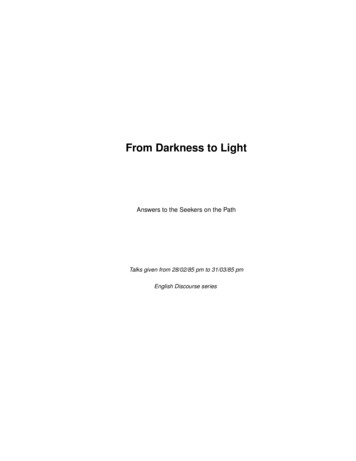
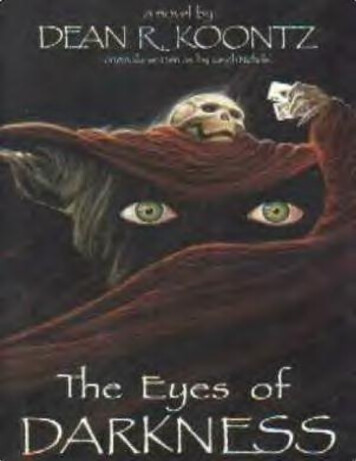
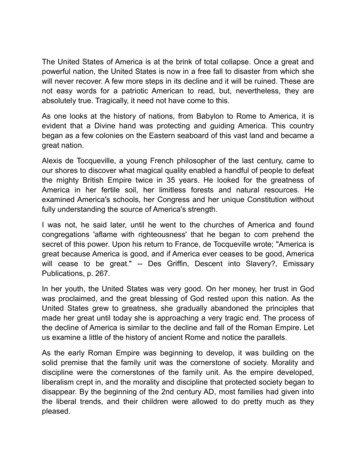
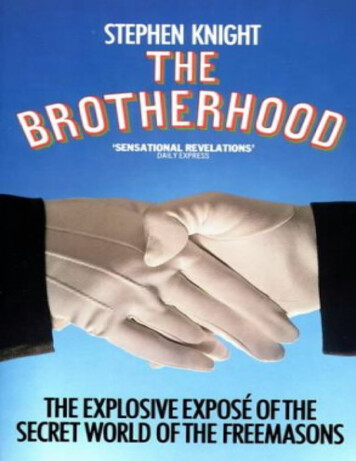

![Fear Nothing [039 5.0] By Dean R. Koontz](/img/5/fearnothing.jpg)
